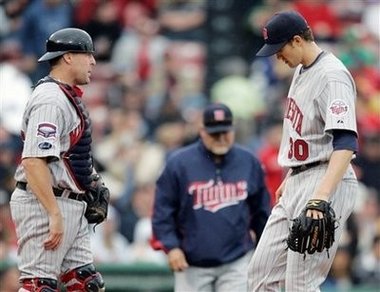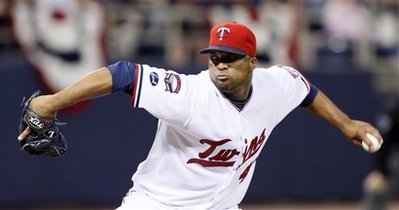June 2, 2009
Twins Through Two Months (Part 2: Pitchers)
TWINS STARTING PITCHING
YEAR IP/G ERA SO9 BB9 HR9 AVG OBP SLG
2008 5.9 4.32 5.6 2.1 1.2 .283 .324 .443
2009 5.9 4.95 5.9 2.5 1.4 .280 .329 .462
If asked to compare this year's rotation to last year's version most fans would probably guess that the numbers are vastly different, but that's not really the case. Yes, the rotation's ERA has risen 15 percent, which is ultimately the problem, but within that Twins starters have been remarkably similar to 2008. They're averaging the same 5.9 innings per start as last season--which would no doubt shock a lot of people--and have allowed a .280/.329/.462 line that's pretty damn close to last year's .283/.324/.443.
Through two months this year's rotation has given up about 15 percent more walks and homers, which matches the rise in ERA. They've also struggled to limit big innings as hitters have seemingly bunched damage together more often, particularly against Baker and Liriano. More walks have led to a slightly higher on-base percentage, more homers have led to a slightly higher slugging percentage, and that extra damage coming in bunches has compounded the problems on the way to a 63-point rise in ERA.
 All of which is a long way of saying that the rotation should improve over the next four months, although it's worth noting that Twins starters ranked just eighth in the league with a 4.32 ERA last year, so even last season they weren't "great" as much as "solid and young." While big innings and ugly ERAs make it seem like Baker and Liriano have totally fallen apart, using Expected Fielding Independent Pitching (xFIP) to strip away the impact of defense, bullpen, and luck paints a somewhat different picture:
All of which is a long way of saying that the rotation should improve over the next four months, although it's worth noting that Twins starters ranked just eighth in the league with a 4.32 ERA last year, so even last season they weren't "great" as much as "solid and young." While big innings and ugly ERAs make it seem like Baker and Liriano have totally fallen apart, using Expected Fielding Independent Pitching (xFIP) to strip away the impact of defense, bullpen, and luck paints a somewhat different picture:
xFIP 2008 2009
Kevin Slowey 4.14 4.43
Scott Baker 4.25 4.74
Nick Blackburn 4.55 4.90
Francisco Liriano 4.40 4.94
Glen Perkins 5.05 5.11
According to xFIP, the rotation's decline has been the result of everyone basically pitching 5-10 percent worse than they did last season, which is a notion that'll be impossible to accept for people who can't get beyond Baker and Liriano both sporting an ERA in the 6.00s. However, neither pitcher has been as bad as his ERA suggests and Liriano in particular has been hurt by some combination of bad luck and poor defense.
FRANCISCO LIRIANO
YEAR SO% BB% GB% LD% LOB% BIP
2008 20.3 9.7 41.6 18.1 68.9 .302
2009 18.9 10.6 38.5 20.9 63.2 .333
There's zero doubt that Liriano's performance has declined. His strikeouts are down seven percent, his walks are up nine percent, and he's given up 15 percent more line drives while inducing seven percent fewer ground balls. However, all of that isn't enough to take his ERA from 3.91 to 6.60. Liriano has also stranded just 63.2 percent of his runners while the Twins' defense has allowed a .333 batting average on his balls in play, both of which are among the worst figures in the AL and somewhat luck-based.
Plenty of people will be quick to blame Liriano for all of that, but in reality defense and luck play a huge role. For instance, in Liriano's last start against the Rays there were at least three instances where the entire outing would've been viewed far differently had a ground ball been converted into an out. But as has been the case in many of Liriano's starts, the balls in play found holes, innings got extended, more damage was done, and his ERA ballooned higher. Baker is a similar story, albeit with more homers.
Calls to remove Liriano from the rotation and replace him with Anthony Swarzak are being fueled by an over-reliance on ERA and lack of understanding about the nuts and bolts of pitching performances. Yes, Liriano has an ugly 6.60, but his 50-to-28 strikeout-to-walk ratio in 58.2 innings and other factors show that he hasn't been nearly that awful. Yes, Swarzak has a 2.08 ERA, but he also has a 6/6 K/BB ratio with an unsustainably amazing 98.5 left-on-base percentage and .205 average on balls in play.
 If this were 1989 or even 1999 it might make sense to champion a rotation switch by saying, "Swarzak has a 2.08 ERA and Liriano has a 6.60 ERA." However, this is 2009 and thanks to the explosion of data and research we know enough about what makes pitchers effective that ERAs fail to accurately depict either performance. Whether you choose to conclude that Swarzak has pitched very well or been very fortunate, if he keeps performing like he has through two starts his ERA will be closer to 6.08 than 2.08.
If this were 1989 or even 1999 it might make sense to champion a rotation switch by saying, "Swarzak has a 2.08 ERA and Liriano has a 6.60 ERA." However, this is 2009 and thanks to the explosion of data and research we know enough about what makes pitchers effective that ERAs fail to accurately depict either performance. Whether you choose to conclude that Swarzak has pitched very well or been very fortunate, if he keeps performing like he has through two starts his ERA will be closer to 6.08 than 2.08.
While that's bad news for Swarzak, it's also good news for Liriano, Baker, and the rest of the rotation, which is likely to do a much better job keeping runs off the board for the final two-thirds of the season. Unfortunately the same isn't necessarily true for the bullpen, which has been about as bad as expected after general manager Bill Smith stubbornly refused to bring in the relief help that the Twins have so obviously needed dating back to the middle of last year. Here's how the primary relievers stack up:
IP xFIP
Joe Nathan 19.1 3.15
Matt Guerrier 25.0 4.12
Jose Mijares 16.2 4.46
R.A. Dickey 30.1 4.99
Luis Ayala 22.2 5.00
Jesse Crain 14.2 5.61
Jose Mijares' call-up and Matt Guerrier's bounceback have patched a couple of the gaping holes, but they've both been merely mediocre as far as primary setup men go and the rest of the bullpen can't be counted on in anything resembling an important spot. Plus, while Joe Nathan remains one of the elite closers in baseball and by far the Twins' best reliever, he's frustratingly been allowed to face a grand total of just 75 batters in 52 games and is quietly looking slightly more human at the age of 34.
If last year is any indication Smith won't bother to bring in any veteran relief help at the trading deadline. Robert Delaney and Anthony Slama are good relief prospects who've consistently posted ridiculous numbers in the minors, yet the Twins just got around to promoting the 24-year-old Delaney to Triple-A yesterday and the 25-year-old Slama remains at Double-A. The Twins have been one good setup man short of a solid bullpen since Pat Neshek went down last May and there's no sign of that changing.
Absolutely dreadful production from three lineup spots has the Twins' offense ranked just eighth in the AL despite Babe Ruth-like production from Joe Mauer and Justin Morneau, whereas the pitching staff also ranks eighth in the league because the young starters have regressed while the shallow bullpen has unfortunately met expectations. I'm fairly confident that the rotation can turn things around, but the bullpen is going to need reinforcements to avoid remaining a clear weakness.
Once you're done here, check out my "Circling The Bases" blog over at NBCSports.com.

